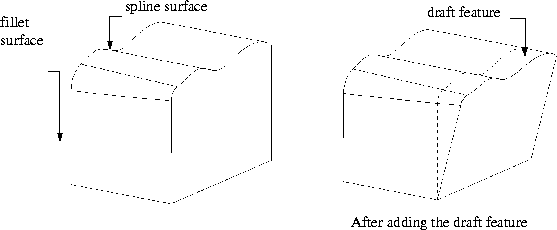



This section describes the geometry representations of the data structures defined in ProGeomitem.h. These structures are output by the geometry functions described in detail in the Geometry.
Topic
Surfaces and edges can be extended from their original domain as the user continues to add features to the model. For example, the user can add a feature such as a draft surface or local push, which requires the original surface to be extended outside its original domain.
When this occurs, you will find that the uv parameters of the surface have been extended. The ProSurfacedata data structure reflects the extension, and returns the updated values for the u and v extents.
Because the evaluator functions use the analytical surface (or curve) definition, they work for any parameter values. Thus, any surface (or curve) can be extended as needed. In addition, if you pass in parameters outside the current uv domain, the evaluator functions still return values for the parameters as requested.
If you are using the evaluators supplied by Pro/TOOLKIT, you do not have to do anything. For surfaces, the evaluator functions work over this extended range of parameters. Your evaluator function for foreign datum surfaces is also expected to allow for extrapolation.
Edges are always parameterized between 0.0 and 1.0. When surfaces are extended, new edges are created that have parameters in the range 0.0 to 1.0.
If you develop your own evaluator functions, you must be aware that the domain of a surface can be extended, as with foreign datum surfaces.

The surface structure contains data that describes the boundary of the surface, and a pointer to the primitive surface on which it lies. The primitive surface is a three-dimensional geometric surface parameterized by two variables (u and v). The surface boundary consists of closed loops (contours) of edges. Each edge is attached to two surfaces, and each edge contains the u and v values of the portion of the boundary that it forms for both surfaces. Surface boundaries are traversed clockwise around the outside of a surface, so an edge has a direction in each surface with respect to the direction of traversal.
Other data found in the surface structure includes the rectangular extents of the two-dimensional domain, the three-dimensional surface, and a flag indicating whether the surface normal points towards the inside or outside of the part. The user data is intended for run-time use only, and this information is not stored with the surface.
This section describes the surface data structures. The data structures are listed in order of complexity. For ease of use, the alphabetical listing of the data structures is as follows:
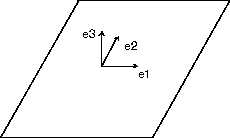
The plane entity consists of two perpendicular unit vectors (e1 and e2), the normal to the plane (e3), and the origin of the plane.
Data Format:
e1[3] Unit vector, in the u direction
e2[3] Unit vector, in the v direction
e3[3] Normal to the plane
origin[3] Origin of the plane
Parameterization:
(x, y, z) = u * e1 + v * e2 + origin
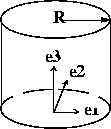
The generating curve of a cylinder is a line, parallel to the axis, at a distance R from the axis. The radial distance of a point is constant, and the height of the point is v.
Data Format:
e1[3] Unit vector, in the u direction
e2[3] Unit vector, in the v direction
e3[3] Normal to the plane
origin[3] Origin of the cylinder
radius Radius of the cylinder
Parameterization:
(x, y, z) = radius * [cos(u) * e1 + sin(u) * e2] +
v * e3 + origin
Engineering Notes:
For the cylinder, cone, torus, and general surface of revolution, a local coordinate system is used that consists of three orthogonal unit vectors (e1, e2, and e3) and an origin. The curve lies in the plane of e1 and e3, and is rotated in the direction from e1 to e2. The u surface parameter determines the angle of rotation, and the v parameter determines the position of the point on the generating curve.
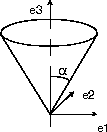
The generating curve of a cone is a line at an angle alpha to the axis of revolution that intersects the axis at the origin. The v parameter is the height of the point along the axis, and the radial distance of the point is v * tan(alpha).
Data Format:
e1[3] Unit vector, in the u direction
e2[3] Unit vector, in the v direction
e3[3] Normal to the plane
origin[3] Origin of the cone
alpha Angle between the axis of the cone
and the generating line
Parameterization:
(x, y, z) = v * tan(alpha) * [cos(u) * e1 +
sin(u) * e2] + v * e3 + origin
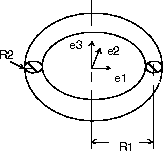
The generating curve of a torus is an arc of radius R2 with its center at a distance R1 from the origin. The starting point of the generating arc is located at a distance R1 + R2 from the origin, in the direction of the first vector of the local coordinate system. The radial distance of a point on the torus is R1 + R2 * cos(v), and the height of the point along the axis of revolution is R2 * sin(v).
Data Format:
e1[3] Unit vector, in the u direction
e2[3] Unit vector, in the v direction
e3[3] Normal to the plane
origin[3] Origin of the torus
radius1 Distance from the center of the
generating arc to the axis of
revolution
radius2 Radius of the generating arc
Parameterization:
(x, y, z) = (R1 + R2 * cos(v)) * [cos(u) * e1 +
sin(u) * e2] + R2 * sin(v) * e3 +
origin
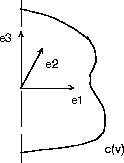
A general surface of revolution is created by rotating a curve entity, usually a spline, around an axis. The curve is evaluated at the normalized parameter v, and the resulting point is rotated around the axis through an angle u. The surface of revolution data structure consists of a local coordinate system and a curve structure.
Data Format:
e1[3] Unit vector, in the u direction
e2[3] Unit vector, in the v direction
e3[3] Normal to the plane
origin[3] Origin of the surface of revolution
curve Generating curve
Parameterization:
curve(v) = (c1, c2, c3) is a point on the curve.
(x, y, z) = [c1 * cos(u) - c2 * sin(u)] * e1 +
[c1 * sin(u) + c2 * cos(u)] * e2 +
c3 * e3 + origin
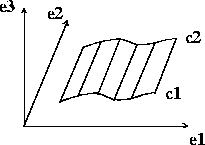
A ruled surface is the surface generated by interpolating linearly between corresponding points of two curve entities. The u coordinate is the normalized parameter at which both curves are evaluated, and the v coordinate is the linear parameter between the two points. The curves are not defined in the local coordinate system of the part, so the resulting point must be transformed by the local coordinate system of the surface.
Data Format:
e1[3] Unit vector, in the u direction
e2[3] Unit vector, in the v direction
e3[3] Normal to the plane
origin[3] Origin of the ruled surface
curve_1 First generating curve
curve_2 Second generating curve
Parameterization:
(x', y', z') is the point in local coordinates.
(x', y', z') = (1 - v) * C1(u) + v * C2(u)
(x, y, z) = x' * e1 + y' * e2 + z' * e3 + origin
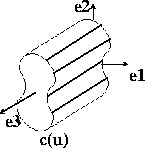
A tabulated cylinder is calculated by projecting a curve linearly through space. The curve is evaluated at the u parameter, and the z coordinate is offset by the v parameter. The resulting point is expressed in local coordinates and must be transformed by the local coordinate system to be expressed in part coordinates.
Data Format:
e1[3] Unit vector, in the u direction
e2[3] Unit vector, in the v direction
e3[3] Normal to the plane
origin[3] Origin of the tabulated cylinder
curve Generating curve
Parameterization:
(x', y', z') is the point in local coordinates.
(x', y', z') = C(u) + (0, 0, v)
(x, y, z) = x' * e1 + y' * e2 + z' * e3 + origin

A Coons patch is used to blend surfaces together. For example, you would use a Coons patch at a corner where three fillets (each of a different radius) meet.
Data Format:
le_curve u = 0 boundary
ri_curve u = 1 boundary
dn_curve v = 0 boundary
up_curve v = 1 boundary
point_matrix[2][2] Corner points
uvder_matrix[2][2] Corner mixed derivatives
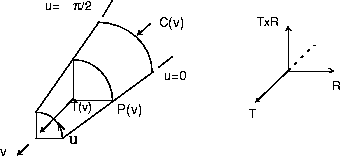
A fillet surface is found where a round or a fillet is placed on a curved edge, or on an edge with non-constant arc radii. On a straight edge, a cylinder would be used to represent the fillet.
Data Format:
pnt_spline P(v) spline running along the u = 0 boundary
ctr_spline C(v) spline along the centers of the
fillet arcs
tan_spline T(v) spline of unit tangents to the
axis of the fillet arcs
Parameterization:
R(v) = P(v) - C(v)
(x,y,z) = C(v) + R(v) * cos(u) + T(v) X R(v) *
sin(u)

The parametric spline surface is a nonuniform bicubic spline surface that passes through a grid with tangent vectors given at each point. The grid is curvilinear in uv space. Use this for bicubic blending between corner points.
Data Format:
u_par_arr[] Point parameters, in the u
direction, of size Nu
v_par_arr[] Point parameters, in the v
direction, of size Nv
point_arr[][3] Array of interpolant points, of
size Nu x Nv
u_tan_arr[][3] Array of u tangent vectors
at interpolant points, of size
Nu x Nv
v_tan_arr[][3] Array of v tangent vectors at
interpolant points, of size
Nu x Nv
uvder_arr[][3] Array of mixed derivatives at
interpolant points, of size
Nu x Nv
Engineering Notes:
The NURBS surface is defined by basis functions (in u and v), expandable arrays of knots, weights, and control points.
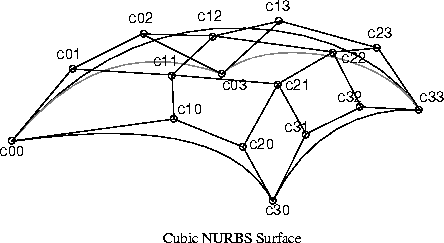
Data Format:
deg[2] Degree of the basis
functions (in u and v)
u_par_arr[] Array of knots on the
parameter line u
v_par_arr[] Array of knots on the
parameter line v
wghts[] Array of weights for
rational NURBS, otherwise
NULL
c_point_arr[][3] Array of control points
Definition:

k = degree in u
l = degree in v
N1 = (number of knots in u) - (degree in u) - 2
N2 = (number of knots in v) - (degree in v) - 2
Bi,k = basis function in u
Bj, l = basis function in v
wij = weights
Ci, j = control points (x,y,z) * wi,j
Engineering Notes:
The weights and c_points_arr arrays represent matrices of size wghts[N1+1] [N2+1] and c_points_arr [N1+1] [N2+1]. Elements of the matrices are packed into arrays in row-major order.
The cylindrical spline surface is a nonuniform bicubic spline surface that passes through a grid with tangent vectors given at each point. The grid is curvilinear in modeling space.
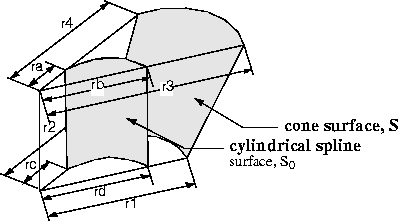
Data Format:
e1[3] x' vector of the local coordinate
system
e2[3] y' vector of the local coordinate
system
e3[3] z' vector of the local coordinate
system, which corresponds to the
axis of revolution of the surface
origin[3] Origin of the local coordinate
system
splsrf Spline surface data structure
The spline surface data structure contains the following fields:
u_par_arr[] Point parameters, in the
u direction, of size Nu
v_par_arr[] Point parameters, in the
v direction, of size Nv
point_arr[][3] Array of points, in
cylindrical coordinates,
of size Nu x Nv. The array
components are as follows:
point_arr[i][0] - Radius
point_arr[i][1] - Theta
point_arr[i][2] - Z
u_tan_arr[][3] Array of u tangent vectors.
in cylindrical coordinates,
of size Nu x Nv
v_tan_arr[][3] Array of v tangent vectors,
in cylindrical coordinates,
of size Nu x Nv
uvder_arr[][3] Array of mixed derivatives,
in cylindrical coordinates,
of size Nu x Nv
Engineering Notes:
If the surface is represented in cylindrical coordinates (r, theta, z), the local coordinate system values (x', y', z') are interpreted as follows:
x' = r cos (theta)
y' = r sin (theta)
z' = z
A cylindrical spline surface can be obtained, for example, by creating a smooth rotational blend (shown in the figure).
In some cases, you can replace a cylindrical spline surface with a surface
such as a plane, cylinder, or cone. For example, in the figure, the cylindrical
spline surface S1 was replaced with a cone
(r1 = r2, r3 =
r4, and r1  r3).
r3).
If a replacement cannot be done (such as for the surface S0 in the
figure (ra  rb or rc
rb or rc  rd)), leave it as a cylindrical spline surface representation.
rd)), leave it as a cylindrical spline surface representation.
The data structures are used to represent edges (line, arc, and spline) as well as the curves (line, arc, spline, and NURBS) within the surface data structures.
This section describes the edge and curve data structures, arranged in order of complexity. For ease of use, the alphabetical listing of the edge and curve data structures is as follows:
Data Format:
end1[3] Starting point of the line
end2[3] Ending point of the line
Parameterization:
(x, y, z) = (1 - t) * end1 + t * end2
The arc entity is defined by a plane in which the arc lies. The arc is centered at the origin, and is parameterized by the angle of rotation from the first plane unit vector in the direction of the second plane vector. The start and end angle parameters of the arc and the radius are also given. The direction of the arc is counterclockwise if the start angle is less than the end angle, otherwise it is clockwise.
Data Format:
vector1[3] First vector that defines the
plane of the arc
vector2[3] Second vector that defines the
plane of the arc
origin[3] Origin that defines the plane
of the arc
start_angle Angular parameter of the starting
point
end_angle Angular parameter of the ending
point
radius Radius of the arc.
Parameterization:
t' (the unnormalized parameter) is
(1 - t) * start_angle + t * end_angle
(x, y, z) = radius * [cos(t') * vector1 +
sin(t') * vector2] + origin
The spline curve entity is a nonuniform cubic spline, defined by a series of three-dimensional points, tangent vectors at each point, and an array of unnormalized spline parameters at each point.
Data Format:
par_arr[] Array of spline parameters
(t) at each point.
pnt_arr[][3] Array of spline interpolant points
tan_arr[][3] Array of tangent vectors at
each point
Parameterization:
x, y, and z are a series of unique cubic functions, one per segment, fully determined by the starting and ending points, and tangents of each segment.
Let p_max be the parameter of the last spline point. Then, t', the unnormalized parameter, is t * p_max.
Locate the ith spline segment such that:
par_arr[i] < t' < par_arr[i+1]
(If t < 0 or t > +1, use the first or last segment.)
t0 = (t' - par_arr[i]) / (par_arr[i+1] - par_arr[i])
t1 = (par_arr[i+1] - t') / (par_arr[i+1] - par_arr[i])
The NURBS (nonuniform rational B-spline) curve is defined by expandable arrays of knots, weights, and control points.
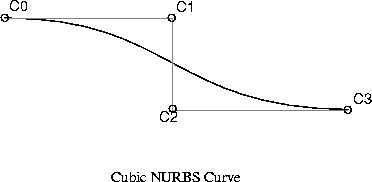
Data Format:
degree Degree of the basis function
params[] Array of knots
weights[] Array of weights for rational
NURBS, otherwise NULL.
c_pnts[][3] Array of control points
Definition:

k = degree of basis function
N = (number of knots) - (degree) - 2
wi = weights
Ci = control points (x, y, z) * wi
Bi,k = basis functions
By this equation, the number of control points equals N+1.
References:
Faux, I.D., M.J. Pratt. Computational Geometry for Design and Manufacture. Ellis Harwood Publishers, 1983.
Mortenson, M.E. Geometric Modeling. John Wiley & Sons, 1985.